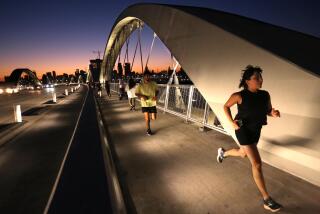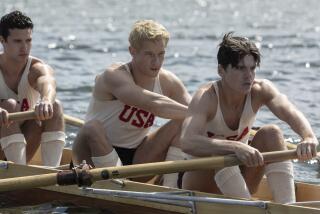There’s No Room for Sissies in an Outrigger
- Share via
On a breezy and overcast afternoon at Redondo Beach, members of the Lanakila outrigger club formed a straight line and lugged a canoe into the choppy King Harbor water.
Lanakila means victory and determination in Hawaiian, which suits members of the club perfectly.
Some are rugby players, former college swimmers and basketball players who have left their original sport momentarily to paddle bright red canoes in the chilly South Bay waters.
“This is definitely not a sissy sport,” said Kellie Whitehead of Manhattan Beach. She’s a former college tennis player and three-year member of the club. “It’s not for petites either. You have to be a broad, a tough broad.”
Al Ching makes sure of that when he rides with his paddlers to see that a quick pace is kept and strokes are big and deep.
During practice, he usually sits at the canoe’s rear and steers it. Periodically the laid-back islander screams, “Let’s go! Warm it up! Now! Deeper!”
The human canoe motors are used to a coach’s constant scolding since a lot of them have been involved in competitive athletics for most of their lives.
Peggy Haslach was a swimmer at Stanford University and a U.S. National water polo team member for two years. Tara Flanagan was an all-conference basketball player at Cal State Northridge, and Jill Schooler plays rugby for a UCLA club team.
Carol Bawer, an Olympic gold medalist on the 1984 U.S. crew team, was a member of Lanakila for seven years.
Former competitive athletes make the best outrigger canoeists because of the sport’s physical and mental demands, although Ching says that due to it’s ocean setting the difficulty of paddling tends to be underestimated. Besides strong conditioning, he says, lots of practice is necessary.
“Dedication is the most important thing,” said the 49-year-old Ching, whose trim, muscular physique makes him appear half his age. “You also need to be very consistent in training, but you really need to be dedicated.”
Ching knows that well. He’s been involved with canoeing for 24 years. He started paddling canoes on fishing and skin-diving trips in his native Hawaii.
He left Oahu to join the Marines and decided to stay in Southern California. Ching and his brother, Ralph Hanalei, paddled for a club in Marina del Rey because there were no South Bay outrigger clubs.
But commuting from Redondo Beach to the Westside became a drag, so in 1970 they formed the Lanakila club.
They started with six men and a mediocre boat yet managed a second-place finish in their first race from Redondo Beach to Marina del Rey.
Later in the season, a women’s team was formed and it’s been one of the more successful groups in the California Outrigger Assn. Today there are 18 female members in the Lanakila, and they participate in 11 races.
This year, the women’s squad hasn’t placed below third in sprint events or below fifth in long races. Usually there are about 25 entries.
The season starts in May with ironman races that go from 10 to 16 miles. That’s followed by the sprint season--known as regatta--with races of half a mile to a mile.
The rest of the season, which goes through September, consists of nine-man races that average 20 miles. They are the most physically demanding.
“At the end you are extremely fatigued,” said 6-foot-1 Flanagan, who also ran cross-country in high school and plays club rugby. “You make your body go non-stop for three hours and the only thing you feel after the race is complete exhaustion.
“I mean, I’ve played a lot of sports, and after this 20-mile race I wondered if I could drive myself home.”
Besides being in shape, athletes have to be ready for just about anything.
A couple of weeks ago in a 20-mile race in Dana Point, two Lanakila paddlers were injured.
One canoe was cruising along the side of a wall about a mile and a half from the finish line when a swell tipped it. One paddler received six stitches for a deep head wound.
On the other Lanakila boat, Haslach caught her foot on the canoe’s jagged edge. The wound required 11 stitches.
“This is very demanding,” Haslach said. “You need extreme cardiovascular strength, agility and balance. And I guess you really need to be careful.”
More to Read
Go beyond the scoreboard
Get the latest on L.A.'s teams in the daily Sports Report newsletter.
You may occasionally receive promotional content from the Los Angeles Times.






